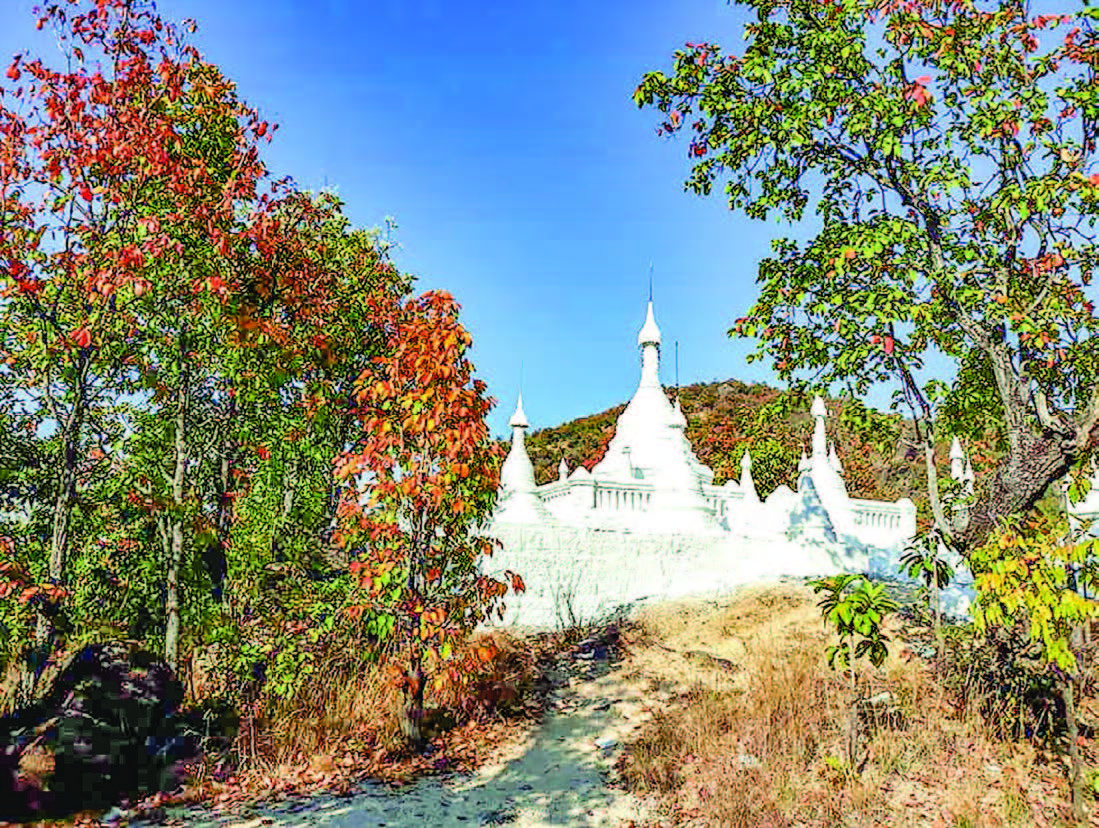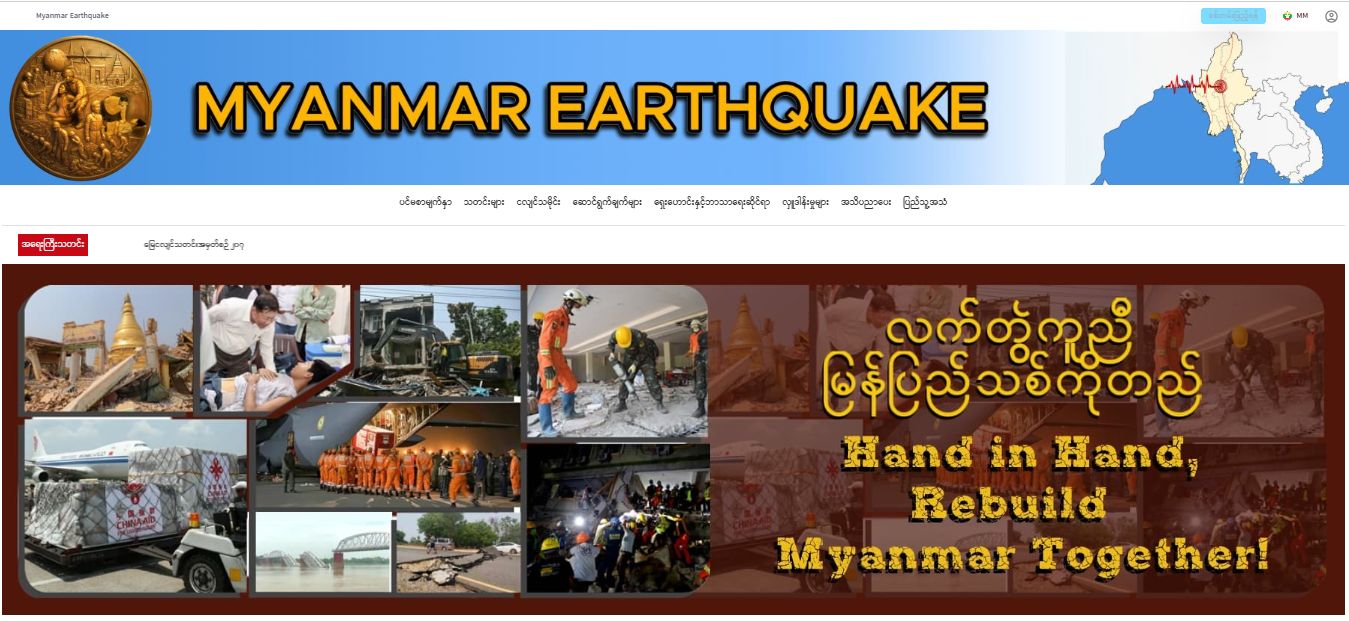April 11, 2020
By Maung Tha (Archaeology)
Pyetkhaywe Hill, which has been famous among local and international travellers in Myanmar since recent years, takes it position near Myathukha Village in Myittha Township of Kyaukse District in Mandalay Region. All experts designated the apex of Pyetkhaywe Hill as the centre of Myanmar. In British colonial era, the land survey department erected a bronze plaque on the apex of the 3,733 feet high hill designated as the centre of Myanmar. Although the bronze plaque was lost, there remains a stone post as the centre of country with a position behind the tooth relic pagoda on the apex.
Pyetkhaywe Hill is located at the point of 21° 12′ north latitude and 96° 14′ east longitude according the map reference.

Historic Myittha
It is an ancient city named Mlittha Kharon included in 11 Letwin districts established by King Anawrahta of Bagan. In the reign of King Badon (1782-1819 AD), nine Letwin districts were constituted with Myaunghla, Myinkhontaing, Panan, Myinsoe and Makkhaya of Zawgyi District and Sawhla, Myittha and Pyimana of Panlaung District.
Kyaukse plain, the granary of the State, crossed by Samon, Samar, Zawgyi, Panlaung and Dokhtawadt rivers, was famous as 11 Letwin districts in the Bagan era. 11 Letwin districts is a common name for combination of 11 guard cities—Panan, Tamok, Myinkhontaing, Ywamone and Thintaung in Kyaukse Township, Pinle, Pyimana and Myittha in Myittha Township and Makkhaya, Tapyettha and Khanlu in Singaing Township.
The records of the Ministry of Home Affairs mentioned the title of Myittha (Mlittha) was given by King Anawrahta. The king reclaimed 800,000 pei of farmlands by building Kinta, Ngalaithei, Pyaungpya, Kyimei, Natet, Thintwe and Minye dams based on Pinlaung and Zawgyi rivers. The records expressed that Kyimei Dam was built as the latest one on Panlaung River. Meanwhile, King Anawrahta pointed to the site for construction of the latest dam on Panlaung River. The area is now called Myittha.
In the time of the government of the Revolutionary Council, the Ministry of Home and Religious Affairs established current Myittha on 31 August 1972 and its wards and village-tracts on 16 June 1973. As such, Myittha Township comprises six wards and 233 villages in 82 village-tracts.
Myittha is 16 miles south of Kyaukse and 48 miles south of Mandalay. The town is 20 miles long from the east to the west and 17.5 miles wide from the south to the north. Myittha Township on 342.63 square miles of land is sharing border with Ywangan Township in the east, Natogyi Township in the west, Wundwin Township in the southwest, Kyaukse Township in the north and TadaU Township in the northwest.
Panlaung River crosses the township from the east to the west and Samon River from the south to the north. The township is teeming with Pyetkhaywe, Palingu, Shweminwun and Mone hills. Two forest reserves—13,700.52 acres of Pyetkhaywe forest reserve and 8,320 acres of Moungkway forest reserve—take positions in the township area.
The tooth relic pagoda on the apex of Pyetkhaywe Hill is one of 10 eminent pagodas including Shwemuhtaw Pagoda in Myittha Township.

Pyetkhaywe
Pyetkhaywe is a name combined with Pyat Hill and Khaywe Hill. It is famous as Taungtawgyi. Local people call Pyetkhaywe as East Taunggyi and West Taunggyi as well as East Pyetkhaywe Hill and West Pyetkhaywe Hill. Khaywe, the east hill is 3,559 feet higher than the sea level and Pyat, the west one, 3,733 feet higher.
Travellers need to turn right from Kume on Yangon-Mandalay highway and then go along a nine-mile road to Kinta Dam. After passing through Khawephyu and Thebyu bridges, southeast of Kume, they need to turn right and then go along the road close to the left main canal of Kinta Dam. They will then reach the bridge of the coffee farm. Afterwards, they should turn left and will reach the foot of Pyetkhaywe Hill. A car park can be seen at the foot of hill.
Travellers have to climb the hill along the jungle route via Mawna monastery starting from the foot of hill near Pyetkhaywe Village by taking about three hours. Bikers can drive along a half mile section of the uphill road and then must climb the hill on foot.

A circular brick stake designated as the centre of Myanmar can be seen on the apex of hill. Likewise, the pagoda assumed as the fifth tooth relic pagoda built by King Anawrahta can be paid homage. Four tooth relic pagodas in Bagan are famous among local and foreign travellers for many years. Now, the tooth relic pagoda on Pyetkhaywe Hill becomes the fifth one.
Mawna and Baungtawkya
Mawna monastery at an altitude of 1,058 feet is a half mile from the foot of Pyetkhaywe Hill. Local people assume that King Anawrahta of Bagan sent an elephant conveying the sacred tooth relic of the Lord Buddha with a vow onto Pyetkhaywe Hill but the elephant took a break due to exhaustion. The site where the elephant took a break was called the place of Mawna monastery.
Mawna monastery takes a position in the place between the east and west Pyetkhaywe hills. The travellers leading onto the hill take a break at Mawna monastery.
Travellers can pay homage to Baungdawkya Pagoda on the route to the hill. Local people believe that in looking up the elephant climbing the hill King’s Anawrahta’s turban fell on the ground. A pagoda built on the venue was named Baungdawkya Pagoda.

The abbot of Mawna monastery explained two two-storey brick buildings near the monastery were assumed as residences of land surveyors in the British colonial era.
Four sacred tooth relics
Four pagodas enshrined with sacred tooth relics of the Lord Buddha built by King Anawrahta were Shwezigon, Lawkananda, Tantkyi Hill pagoda and Tuyin Hill pagoda. Myanmar Buddhists believe if they could pay homage to four sacred tooth relic pagodas within a day and donate offerings in equal term, they would gain great merits.
Compilers of histories and records wrote a sacred tooth relic each of the Lord Buddha was enshrined at four pagodas. Shwezigon and Lawkananda pagodas are located in NyaungU and Bagan whereas another pagoda takes position on Tuyin Hill between NyaungU and Kyaukpadaung and last one on Tantkyi Hill on the western bank of Ayeyawady River.
In fact, King Anawrahta gave treatises of Tri Pitakat, members of the Sangha and a white elephant requested by King Vijayabahu I of Ceylon Island. The king of Ceylon donated a duplicate tooth relic as Dhamma gift to King Anawrahta.
King Anawrahta enshrined the duplicate tooth relic at Shwezigon Pagoda and another one on the elephant sent to the deserved place for building the pagoda with a vow. The elephant took a break at Tantkyi Hill and on the highland near the jetty of Ayeyawady River. For the last one, the elephant stopped on Tuyin Hill.
King Anawrahta built four pagodas enshrined with a tooth relic each in four places where the elephant took a break. These pagodas are famous as four tooth relics.
Among four tooth relic pagodas, Lawkananda Pagoda was built in 1059 AD and Shwezigon Pagoda in 1060 AD. Both pagodas are now about 1,000 years old. The tooth relic pagodas on Tantkyi and Tuyin hills have been renovated as new ones losing original styles.
The fifth tooth relic pagoda
King Anawrahta made a vow and sent an elephant carrying a lower left tooth relic of the Lord Buddha so as to build a pagoda enshrined with such tooth relic.
The Buddha Pujaniya festival of Pyetkhaywe tooth relic pagoda is held from 13th waxing to the full moon day of Thadingyut yearly. It is a famous festival in Myittha Township.
Despite finding firm evidences related to the tooth relic pagoda, number of tourist arrivals at Pyetkhaywe Hill which is centre of Myanmar is on the increase year by year. The travellers leading to Pyetkhaywe Hill prefer to climb onto more than 3,000 feet high hill along the jungle routes and are satisfied with paying homage to the tooth relic pagoda on the apex of hill. (Translated by Than Tun Aung)
References:
Eleven Myittha Districts, the milestone in history (Lin Htaik Tin Hlaing, Kyaukse)
The centre of Myanmar versus fifth tooth relic pagoda (Taikkyi, Singaing)



